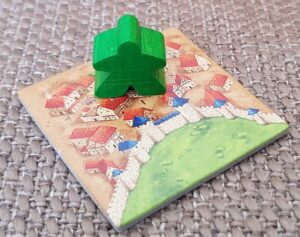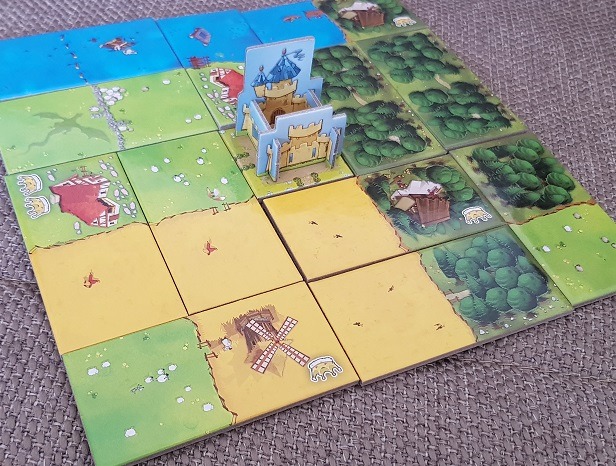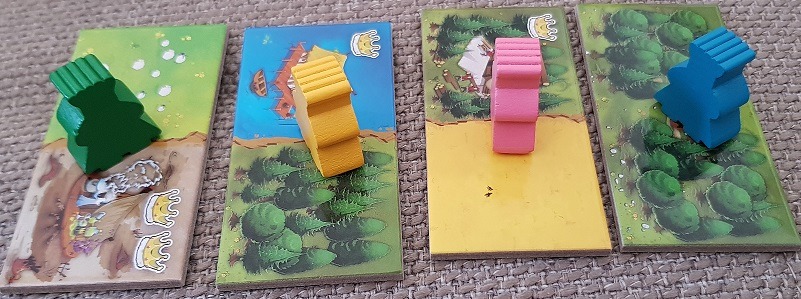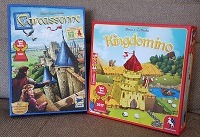When it comes to tile-placing mechanics, you’ll often come across two titles as the board game genre’s main representatives. This article puts them side by side, Carcassonne vs Kingdomino, and compares their features and game mechanics.
If you’re on the verge of buying a tile-placing title, it may just steer you in the right direction.
Carcassonne Facts
Year published: 2000
Number of players: 2-5
Playing time: 30-45 minutes
Suggested player age: 8+
Complexity rating (according to BGG): 1.92/5
Average rating (according to BGG): 7.4/10

Main features:
- Picturesque medieval landscape.
- The Scoring system allows for various strategies.
- Part of a massive Carcassonne family.
Expansions/Editions:
Frankly, the repertoire (you can find the full list on Wikipedia) of Carcassonne games is so large, it is beyond the scope of this article. Most of them are smaller additions, adding a few new pieces, some tiles, and/or an interesting new game mechanic. It’s worth looking for compilation boxes that include several of those in one package.
On top of those, there are also numerous spin-offs that share a theme or a mechanic with the base game.
Click here to read my full review of Carcassonne
Kingdomino Facts
Year published: 2016
Number of players: 2-4
Playing time: 15-20 minutes
Suggested player age: 6+
Complexity rating (according to BGG): 1.20/5
Average rating (according to BGG): 7.4/10
Main features:
- Very easy to learn.
- Challenging tile claiming system.
- Colorful, playful theme.
Expansions/Editions:
- Age of Giants adds new tiles and Giant tokens, that are used as a penalty to cover up crowns on your tiles (or you can give them to your opponents to mess with them). It adds another layer of strategy and also works with Queendomino.
- The Court is a free print-and-play expansion for both Kingdomino and Queendomino. It introduces resources and royal characters into the game. Resources are placed on tiles and can be used to buy characters, which work as extra crowns.
- Queendomino is a standalone game that upgrades Kingdomino’s mechanics by adding buildings, currency, knights, and the Queen herself. It is a very good upgrade on almost every aspect of the game and can be combined with Kingdomino and the above expansions.
Click here to read more about Kingdomino and Queendomino
Theme
This is probably the first thing you’ll notice when looking at the two games. Carcassonne’s idea is based on the medieval map of the city of Carcassonne and its surroundings, which featured a combination of fields, towns, monasteries, and roads. The theme draws from that: it tries to reproduce a somewhat realistic image of a landscape.
Kingdomino uses classic Grimm fairy tales as background. Terrain types (forests, fields, pastures, etc.) are bright and colorful, almost playful. They are full of details (you can notice Puss in Boots on one of the tiles, for example) and when you look at the end result, you feel like a child who just drew a picture with crayons.

Shared map against your own kingdom
Another very apparent difference. In Carcassonne, all players place tiles on the same board, while in Kingdomino, each has its own Kingdom to complete.
This affects player interaction and the overall flow of the game. Player interaction in Carcassonne is done by blocking on the map directly, while in Kingdomino the interaction is more delicate. It happens during the tile selection: keeping an eye out for your opponent’s kingdom, reserving strategic tiles, etc. It’s more of indirect interaction.
Tiles
Looking at the tiles themselves, the obvious thing is the size. Carcassonne features 1×1 tiles, while Kingdomino is based around 2×1 dominoes. But this itself does not tell much – it’s the number of features on those tiles that matter.
Each Kingdomino tile has only one terrain type on it (so a maximum of two per domino) and it must touch the same terrain when placed.
Carcassonne’s tiles are much more detailed. There are towns, roads, and fields, sometimes all on the same tile. When placing a tile, you must make sure that every side of it matches the neighboring one perfectly.
It’s actually easier than it first sounds and the end result is a continuous patch of connected terrain that all looks like it was meant to fit.

Draw
Carcassonne doesn’t beat around the bush. You draw a tile and then you place it. That’s all there is to it.
Kingdomino’s system is much more interesting. On every round, a new row of dominoes will be laid down, sorted by their value. Players will mark the dominoes as theirs by placing a king token on them.
The trick is that the first player (that has a king placed on the top domino) now has the first pick on the dominoes in the second row (which are already laid out). So, if you picked the “worst” domino in this round, you’ll have a chance to pick the “best” in the next one and vice-versa.
It requires some strategy and planning. Sometimes you’ll pick a worse domino, just to have the first pick in the following round.

Scoring
When it comes to scoring, Kingdomino sticks to simplicity. Simple equation: number of connected same terrain tiles times the number of crowns on them. Then just add all the different terrain types together.
Carcassonne is slightly more complicated. During the game, you will place meeples on features like roads, towns, and monasteries. These are scored immediately upon completion. When a feature is completed, you get your meeple back – unless it’s a field, those are not returned and are scored at the end.
How much a feature scores is based on its size (road length, town size) and possible bonuses on them (shields). Fields are scored by the number of completed towns adjacent to them and are considered as an investment: investing a meeple and paying off at the end of the game.
A combination of different features, scoring abilities, complete and incomplete features, fields, and a limited number of your meeples are the main strategic drive in Carcassonne.
Carcassonne vs Kingdomino – which one to buy?
Hopefully, by now you have a general feel of how the games go and which one attracts you more. Because, objectively speaking, there’s no obvious winner here.
Although some things are shared, both games have enough of their own mechanics and features that make them set apart. At a certain point in your board gaming career, you should at least try out both.
What makes this easier, is the low entry price point for both games. As they’re pretty mainstream, they’re often available at general stores at a discount. So go check that games department next time.
Further Reading:
